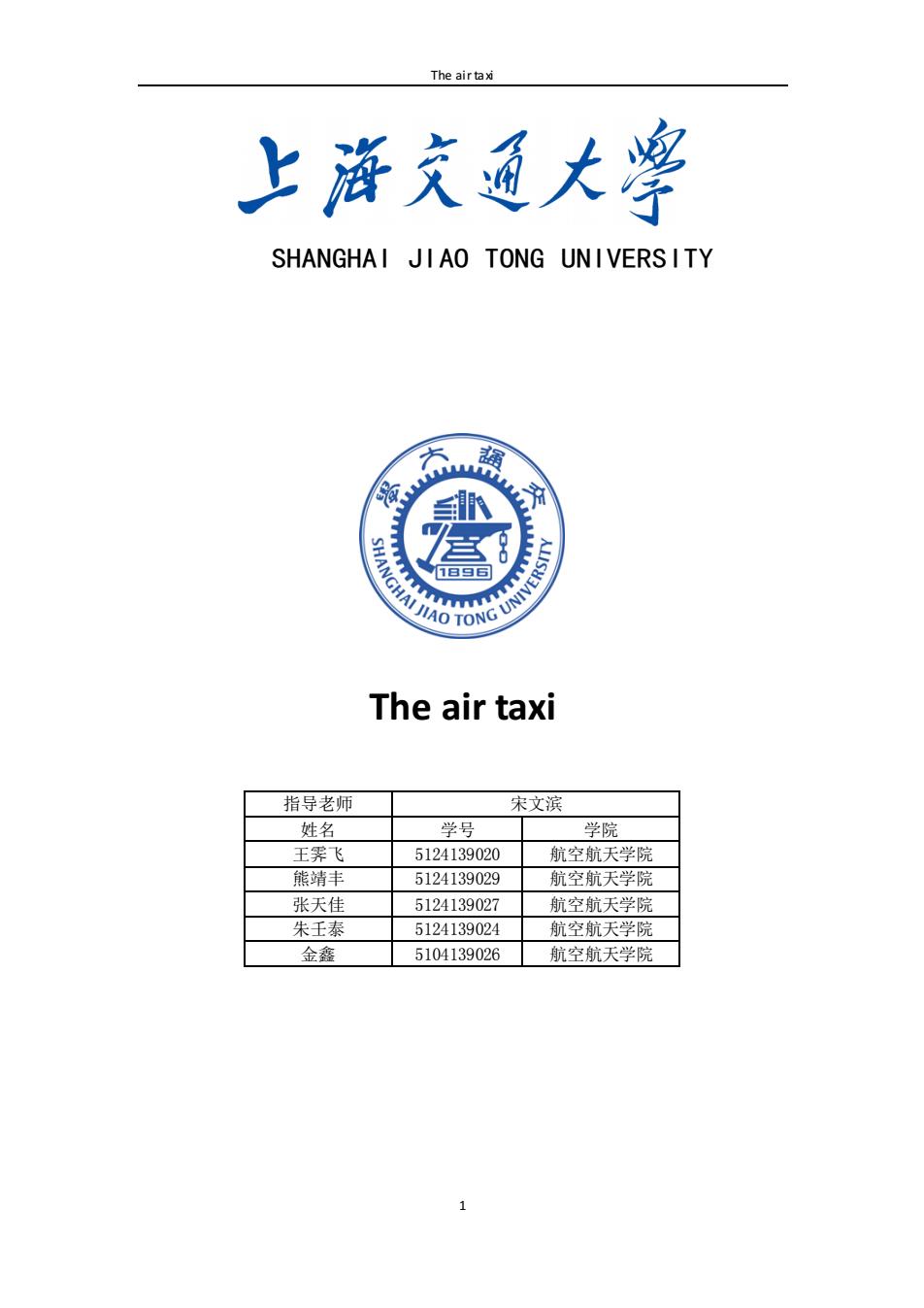
The airtaxi 上游天通大警 SHANGHAI JIAO TONG UNIVERSITY SHANGHALJIAO TONG UNIVERST The air taxi 指导老师 宋文滨 姓名 学号 学院 王霁飞 5124139020 航空航天学院 熊靖丰 5124139029 航空航天学院 张天佳 5124139027 航空航天学院 朱壬泰 5124139024 航空航天学院 金鑫 5104139026 航空航天学院
The air taxi 1 SHANGHAI JIAO TONG UNIVERSITY The air taxi 指导老师 宋文滨 姓名 学号 学院 王霁飞 5124139020 航空航天学院 熊靖丰 5124139029 航空航天学院 张天佳 5124139027 航空航天学院 朱壬泰 5124139024 航空航天学院 金鑫 5104139026 航空航天学院
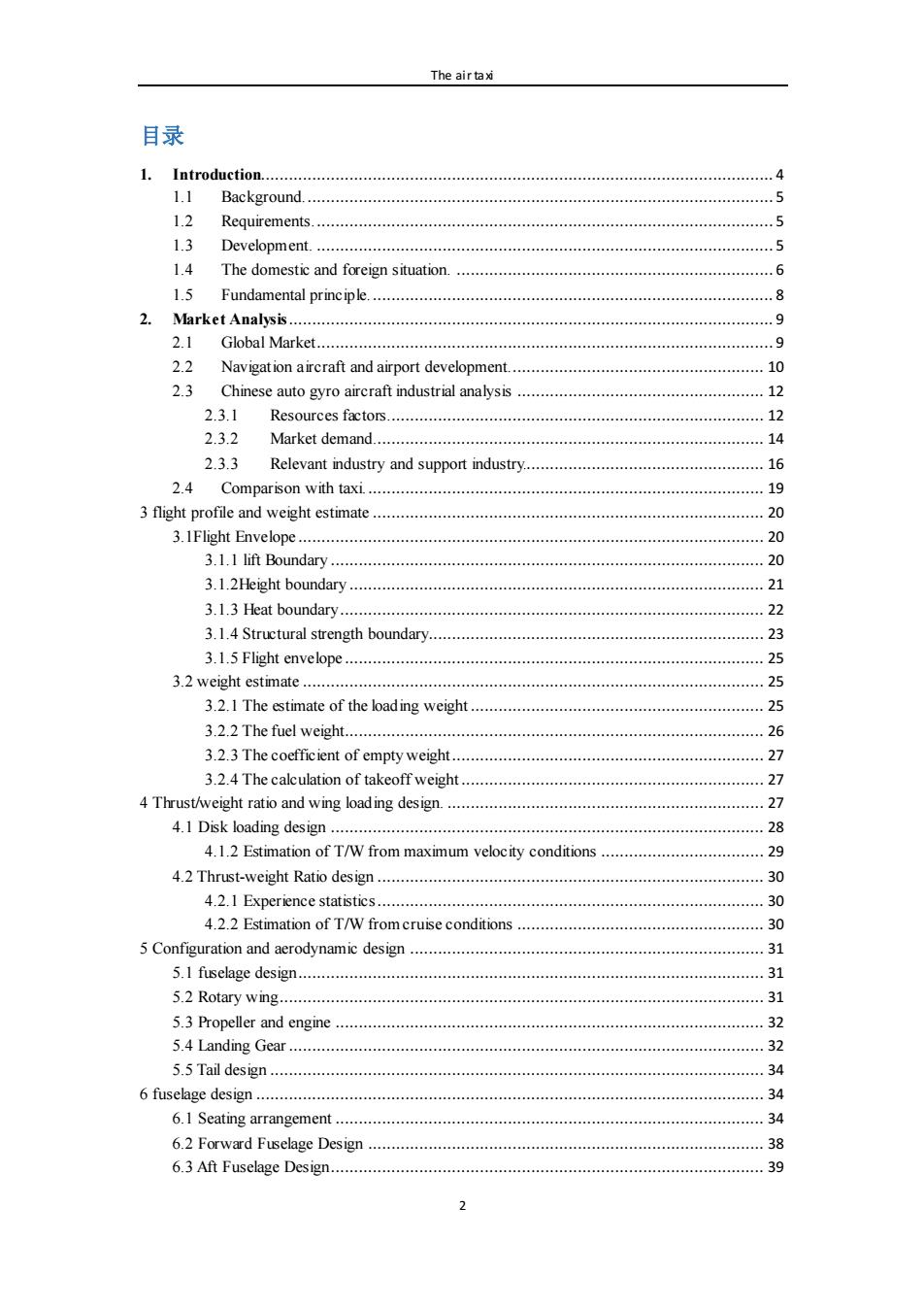
The airta对 目录 1.Introduction..… 4 1.1 Background.… .5 1.2 Requirements.… .5 1.3 Development... .5 1.4 The domestic and foreign situation. .6 1.5 Fundamental principle.. 8 2.Market Ana小sis.… .9 2.1 Global Market..... .9 2.2 Navigation aircraft and airport development.. 10 2.3 Chinese auto gyro aircraft industrial analysis12 2.3.1 Resources factors... 2.3.2 Market demand..… .14 2.3.3 Relevant industry and support industry. .16 2.4 Comparison with taxi 19 3 flight profile and weight estimate............. 20 3.IFlight Envelope... .20 3.1.I lift Boundary. 20 3.1.2Height 3.1.3 Heat boundary...... 22 3.1.4 Structural strength boundary..23 3.1.5 Flight envelope.. 25 3.2 weight estimate... 25 3.2.1 The estimate of the loading weight....... 25 3.2.2 The fuel weight... …26 3.2.3 The coefficient of empty weight.......... 27 3.2.4 The calculation of takeoff weight....... 27 4 Thrust/weight ratio and wing loading design..27 4.I Disk loading design.. 28 4.1.2 Estimation of T/W from maximum velocity conditions.9 4.2 Thrust-weight Ratio design.......... 30 4.2.1 Experience statistics.30 4.2.2 Estimation of T/W from cruise conditions 30 5 Configuration and aerodynamic design ......... …31 5.I fuselage design..... 31 5.2 Rotary wing.… 31 5.3 Propeller and engine....... 32 5.4 Landing Gear........ 32 5.5 Tail design.… 34 6 fuselage design.. 34 6.1 Seating arrangement ........... .34 6.2 Forward Fuselage Design 38 6.3 Aft Fuselage Design............. …39
The air taxi 2 目录 1. Introduction.............................................................................................................. 4 1.1 Background..................................................................................................... 5 1.2 Requirements................................................................................................... 5 1.3 Development. .................................................................................................. 5 1.4 The domestic and foreign situation. .................................................................... 6 1.5 Fundamental principle....................................................................................... 8 2. Market Analysis........................................................................................................ 9 2.1 Global Market.................................................................................................. 9 2.2 Navigation aircraft and airport development....................................................... 10 2.3 Chinese auto gyro aircraft industrial analysis ..................................................... 12 2.3.1 Resources factors................................................................................. 12 2.3.2 Market demand.................................................................................... 14 2.3.3 Relevant industry and support industry.................................................... 16 2.4 Comparison with taxi...................................................................................... 19 3 flight profile and weight estimate .................................................................................... 20 3.1Flight Envelope .................................................................................................... 20 3.1.1 lift Boundary ............................................................................................. 20 3.1.2Height boundary ......................................................................................... 21 3.1.3 Heat boundary........................................................................................... 22 3.1.4 Structural strength boundary........................................................................ 23 3.1.5 Flight envelope .......................................................................................... 25 3.2 weight estimate ................................................................................................... 25 3.2.1 The estimate of the loading weight ............................................................... 25 3.2.2 The fuel weight.......................................................................................... 26 3.2.3 The coefficient of empty weight................................................................... 27 3.2.4 The calculation of takeoff weight ................................................................. 27 4 Thrust/weight ratio and wing loading design. .................................................................... 27 4.1 Disk loading design ............................................................................................. 28 4.1.2 Estimation of T/W from maximum velocity conditions ................................... 29 4.2 Thrust-weight Ratio design ................................................................................... 30 4.2.1 Experience statistics................................................................................... 30 4.2.2 Estimation of T/W from cruise conditions ..................................................... 30 5 Configuration and aerodynamic design ............................................................................ 31 5.1 fuselage design.................................................................................................... 31 5.2 Rotary wing........................................................................................................ 31 5.3 Propeller and engine ............................................................................................ 32 5.4 Landing Gear ...................................................................................................... 32 5.5 Tail design .......................................................................................................... 34 6 fuselage design ............................................................................................................. 34 6.1 Seating arrangement ............................................................................................ 34 6.2 Forward Fuselage Design ..................................................................................... 38 6.3 Aft Fuselage Design............................................................................................. 39
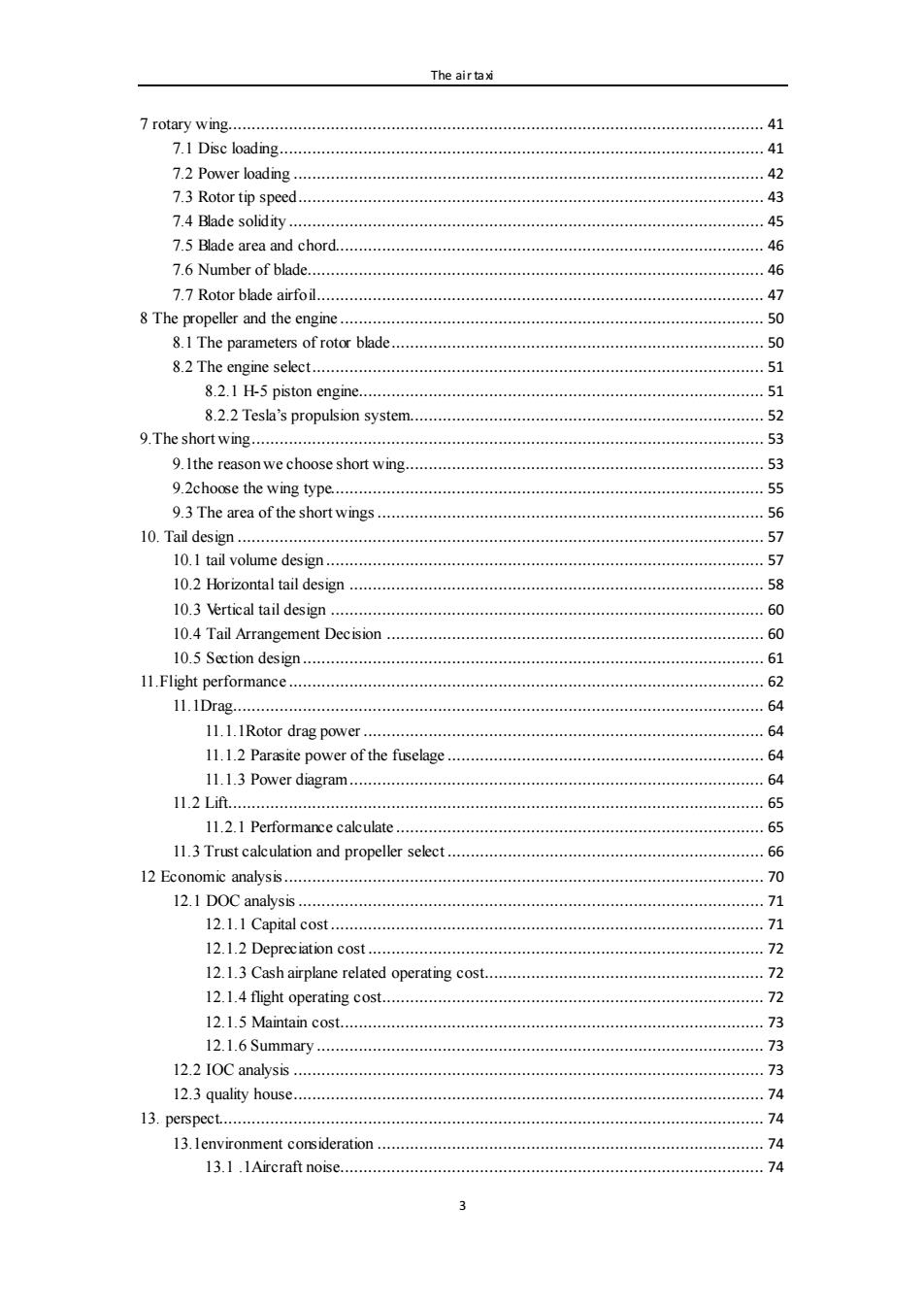
The airta对 7 rotary wing.… 41 7.1 Disc loading.… 41 7.2 Power loading. 42 7.3 Rotor tip speed... 形 7.4 Blade solidity............. 45 7.5 Blade area and chord.. 46 7.6 Number of blade........... 46 7.7 Rotor blade airfoil............. % 8 The propeller and the engine............. 50 8.1 The parameters of rotor blade. 50 8.2 The engine select..... 51 8.2.1 H-5 piston engine.............. 51 8.2.2 Tesla's propulsion system.. 52 9.The short wing.… .53 9.Ithe reason we choose short wing 53 9.2choose the wing type........... 55 9.3 The area of the short wings... .56 l0.Tail design.… .57 10.1 tail volume design........... 57 10.2 Horizontal tail design... 58 10.3 Vertical tail design.... 60 10.4 Tail Arrangement Decision.. 60 l0.5 Section design.… 61 11.Flight performance...... .62 11.IDrag.. 64 11.1.1Rotor drag power....... 64 11.1.2 Parasite power of the fuselage 64 11.1.3 Power diagram.......... 64 11.2Lif.… 65 11.2.1 Performance calculate......... 65 11.3 Trust calculation and propeller select... 66 12 Economic analysis...... 70 12.1 DOC analysis.… 之 12.1.1 Capital cost........ 71 12.1.2 Depreciation cost...... 72 12.1.3 Cash airplane related operating cost. 72 12.1.4 flight operating cost....... 72 12.1.5 Maintain cost.... 73 12.1.6 Summary.... 73 12.2 IOC analysis… 73 12.3 quality house...... 74 l3.perspect.… 74 13.lenvironment consideration 74 13.1.1Aircraft noise........... 74
The air taxi 3 7 rotary wing................................................................................................................... 41 7.1 Disc loading........................................................................................................ 41 7.2 Power loading ..................................................................................................... 42 7.3 Rotor tip speed.................................................................................................... 43 7.4 Blade solidity ...................................................................................................... 45 7.5 Blade area and chord............................................................................................ 46 7.6 Number of blade.................................................................................................. 46 7.7 Rotor blade airfoil................................................................................................ 47 8 The propeller and the engine ........................................................................................... 50 8.1 The parameters of rotor blade................................................................................ 50 8.2 The engine select................................................................................................. 51 8.2.1 H-5 piston engine....................................................................................... 51 8.2.2 Tesla’s propulsion system............................................................................ 52 9.The short wing.............................................................................................................. 53 9.1the reason we choose short wing............................................................................. 53 9.2choose the wing type............................................................................................. 55 9.3 The area of the short wings ................................................................................... 56 10. Tail design ................................................................................................................. 57 10.1 tail volume design .............................................................................................. 57 10.2 Horizontal tail design ......................................................................................... 58 10.3 Vertical tail design ............................................................................................. 60 10.4 Tail Arrangement Decision ................................................................................. 60 10.5 Section design ................................................................................................... 61 11.Flight performance ...................................................................................................... 62 11.1Drag.................................................................................................................. 64 11.1.1Rotor drag power ...................................................................................... 64 11.1.2 Parasite power of the fuselage .................................................................... 64 11.1.3 Power diagram......................................................................................... 64 11.2 Lift................................................................................................................... 65 11.2.1 Performance calculate ............................................................................... 65 11.3 Trust calculation and propeller select .................................................................... 66 12 Economic analysis....................................................................................................... 70 12.1 DOC analysis .................................................................................................... 71 12.1.1 Capital cost ............................................................................................. 71 12.1.2 Depreciation cost ..................................................................................... 72 12.1.3 Cash airplane related operating cost............................................................ 72 12.1.4 flight operating cost.................................................................................. 72 12.1.5 Maintain cost........................................................................................... 73 12.1.6 Summary ................................................................................................ 73 12.2 IOC analysis ..................................................................................................... 73 12.3 quality house..................................................................................................... 74 13. perspect..................................................................................................................... 74 13.1environment consideration ................................................................................... 74 13.1 .1Aircraft noise........................................................................................... 74
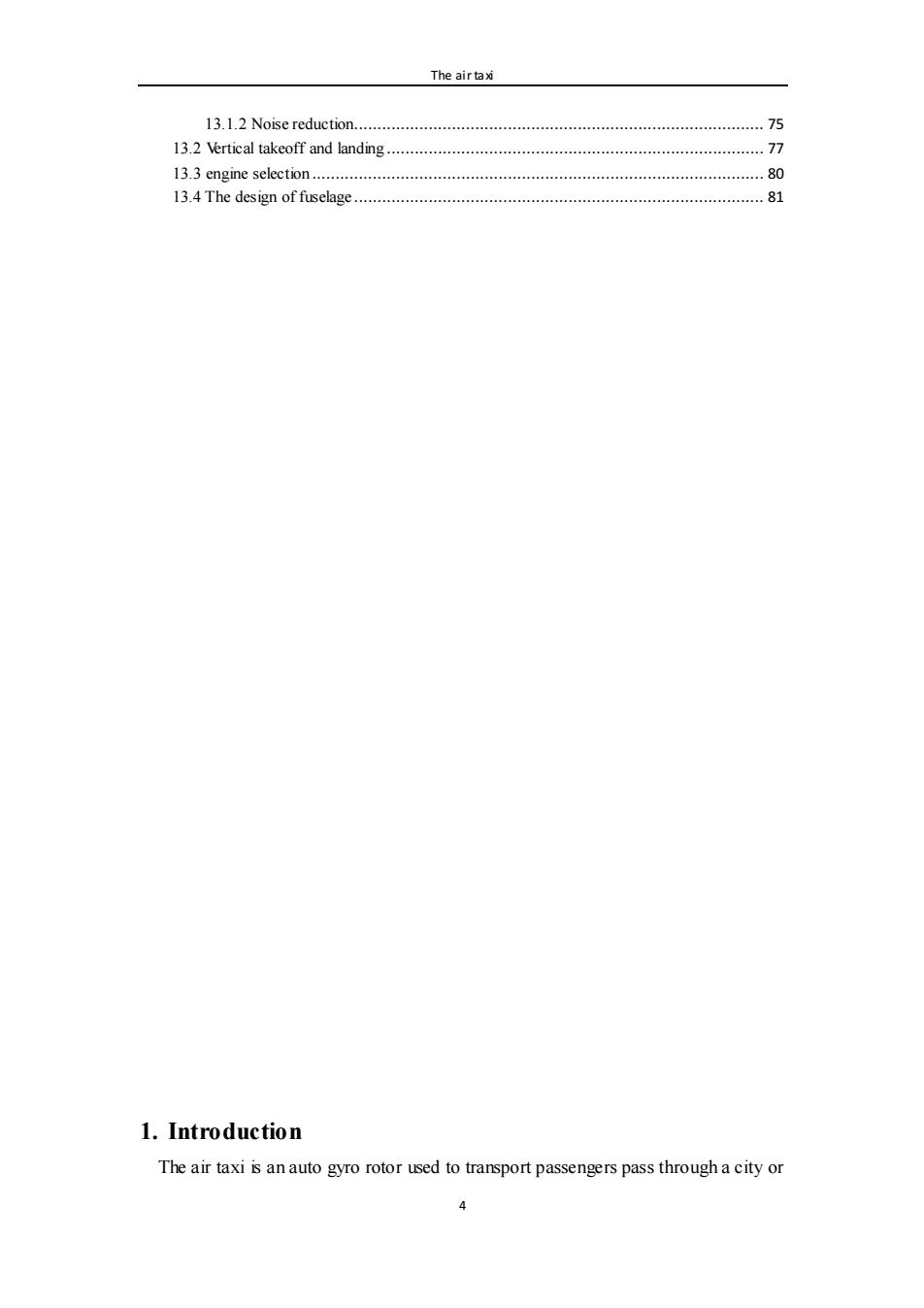
The airta对 13.1.2 Noise reduction................................................75 13.2 Vertical takeoff and landing.. 13.3 engine selection......... 80 13.4 The design of fuselage............... .81 1.Introduction The air taxi is an auto gyro rotor used to transport passengers pass through a city or
The air taxi 4 13.1.2 Noise reduction........................................................................................ 75 13.2 Vertical takeoff and landing ................................................................................. 77 13.3 engine selection ................................................................................................. 80 13.4 The design of fuselage ........................................................................................ 81 1. Introduction The air taxi is an auto gyro rotor used to transport passengers pass through a city or
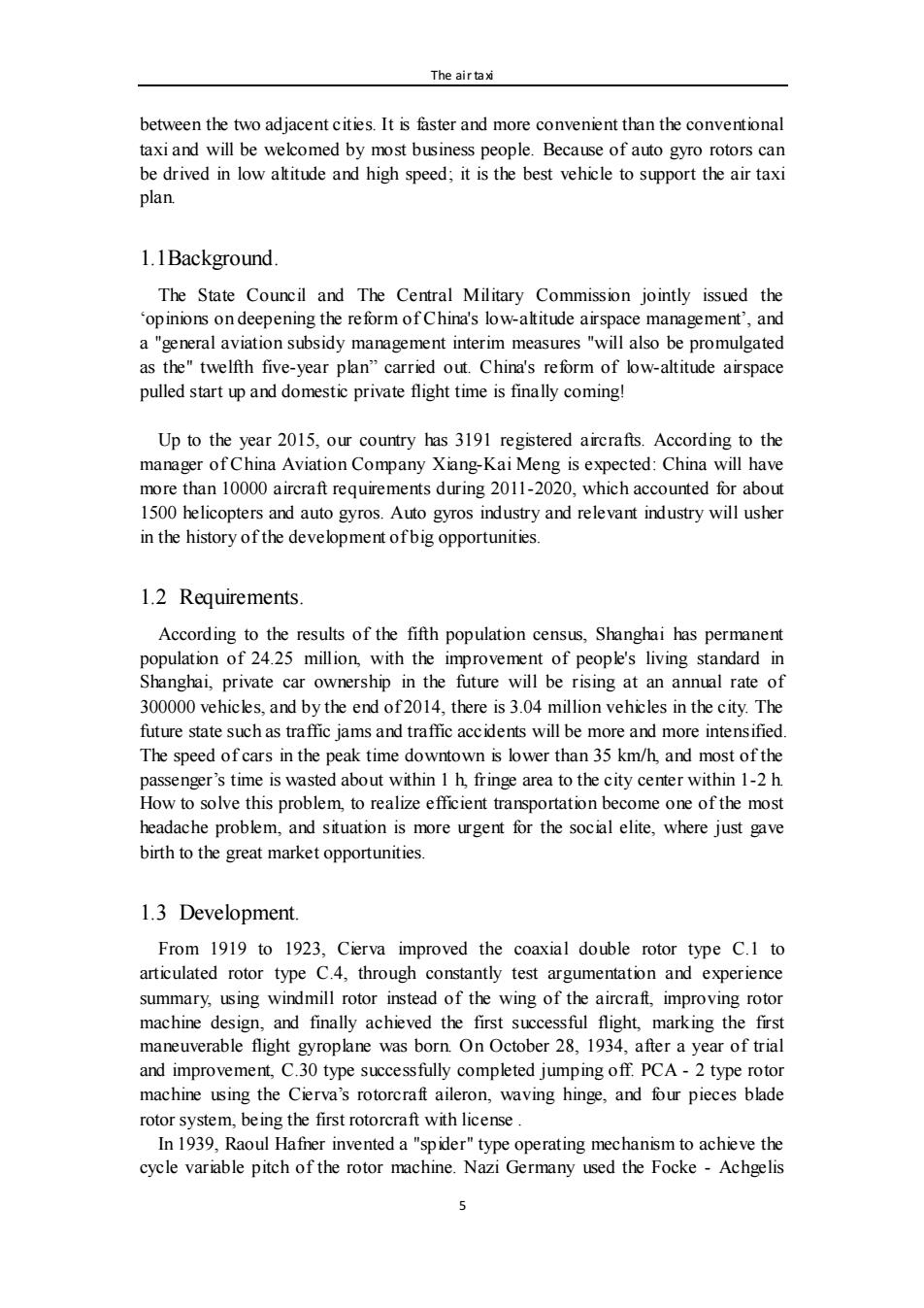
The airta对 between the two adjacent cities.It is faster and more convenient than the conventional taxi and will be welcomed by most business people.Because of auto gyro rotors can be drived in low altitude and high speed;it is the best vehicle to support the air taxi plan. 1.1Background The State Council and The Central Military Commission jointly issued the opinions on deepening the reform of China's low-altitude airspace management',and a "general aviation subsidy management interim measures "will also be promulgated as the"twelfth five-year plan"carried out.China's reform of low-altitude airspace pulled start up and domestic private flight time is finally coming! Up to the year 2015,our country has 3191 registered aircrafts.According to the manager of China Aviation Company Xiang-Kai Meng is expected:China will have more than 10000 aircraft requirements during 2011-2020,which accounted for about 1500 helicopters and auto gyros.Auto gyros industry and relevant industry will usher in the history of the development ofbig opportunities. 1.2 Requirements. According to the results of the fifth population census,Shanghai has permanent population of 24.25 million,with the improvement of people's living standard in Shanghai,private car ownership in the future will be rising at an annual rate of 300000 vehicles,and by the end of 2014,there is 3.04 million vehicles in the city.The future state such as traffic jams and traffic accidents will be more and more intensified. The speed of cars in the peak time downtown is lower than 35 km/h,and most of the passenger's time is wasted about within I h,fringe area to the city center within 1-2 h. How to solve this problem,to realize efficient transportation become one of the most headache problem,and situation is more urgent for the social elite,where just gave birth to the great market opportunities. 1.3 Development. From 1919 to 1923,Cierva improved the coaxial double rotor type C.1 to articulated rotor type C.4,through constantly test argumentation and experience summary,using windmill rotor instead of the wing of the aircraft,improving rotor machine design,and finally achieved the first successful flight,marking the first maneuverable flight gyroplane was born.On October 28,1934,after a year of trial and improvement,C.30 type successfully completed jumping off.PCA-2 type rotor machine using the Cierva's rotorcraft aileron,waving hinge,and four pieces blade rotor system,being the first rotorcraft with license. In 1939,Raoul Hafner invented a "spider"type operating mechanism to achieve the cycle variable pitch of the rotor machine.Nazi Germany used the Focke -Achgelis
The air taxi 5 between the two adjacent cities. It is faster and more convenient than the conventional taxi and will be welcomed by most business people. Because of auto gyro rotors can be drived in low altitude and high speed; it is the best vehicle to support the air taxi plan. 1.1Background. The State Council and The Central Military Commission jointly issued the ‘opinions on deepening the reform of China's low-altitude airspace management’, and a "general aviation subsidy management interim measures "will also be promulgated as the" twelfth five-year plan” carried out. China's reform of low-altitude airspace pulled start up and domestic private flight time is finally coming! Up to the year 2015, our country has 3191 registered aircrafts. According to the manager of China Aviation Company Xiang-Kai Meng is expected: China will have more than 10000 aircraft requirements during 2011-2020, which accounted for about 1500 helicopters and auto gyros. Auto gyros industry and relevant industry will usher in the history of the development of big opportunities. 1.2 Requirements. According to the results of the fifth population census, Shanghai has permanent population of 24.25 million, with the improvement of people's living standard in Shanghai, private car ownership in the future will be rising at an annual rate of 300000 vehicles, and by the end of 2014, there is 3.04 million vehicles in the city. The future state such as traffic jams and traffic accidents will be more and more intensified. The speed of cars in the peak time downtown is lower than 35 km/h, and most of the passenger’s time is wasted about within 1 h, fringe area to the city center within 1-2 h. How to solve this problem, to realize efficient transportation become one of the most headache problem, and situation is more urgent for the social elite, where just gave birth to the great market opportunities. 1.3 Development. From 1919 to 1923, Cierva improved the coaxial double rotor type C.1 to articulated rotor type C.4, through constantly test argumentation and experience summary, using windmill rotor instead of the wing of the aircraft, improving rotor machine design, and finally achieved the first successful flight, marking the first maneuverable flight gyroplane was born. On October 28, 1934, after a year of trial and improvement, C.30 type successfully completed jumping off. PCA - 2 type rotor machine using the Cierva’s rotorcraft aileron, waving hinge, and four pieces blade rotor system, being the first rotorcraft with license . In 1939, Raoul Hafner invented a "spider" type operating mechanism to achieve the cycle variable pitch of the rotor machine. Nazi Germany used the Focke - Achgelis